Sunrise over Theophilus
The
images below were obtained
on 22 June 2004 Pacific Daylight Time
at prime focus of my Takahashi FS-102 using a Philips ToUcam Pro with an
IR blocking filter. The imaging session
spanned approximately 8 hours from
about 3:15pm to 11:20pm at Hidden Hills
Observatory, the dark sky site of the Tri-Valley Stargazers. Five
minute videos (captured at 2 frames/second) were obtained every 10
minutes,
resulting in 48 videos over the 8 hour session. Eight of the images
were rejected from use in the movie because they were too out of focus.
Theophilus lies at the western edge
of Mare
Nectaris, located in the mid-upper right of the movie below, and the
near center of the Eastern Hemisphere image below. This crater is 110km
in diameter, and it is one of the deepest craters on the Moon at 4.1km.
It is a Tycho class crater which means it is characterized by "terraced
walls, a flat floor, and broad central peaks" (p. 113, The Modern Moon:
A Personal View, Charles Wood, Sky Publishing Corporation).
Fracastorius lies at the southern edge of Mare Nectaris. You'll notice
that it's northern rim has all but disappeared. It is believed that
lava that filled Mare Nectaris caused subsidence due to its massive
weight, with the result that Fracastorius tilted toward the center of
Mare Nectaris. Subsequent lava flows buried its northern rim. Further
south is Piccolomini (I just love that name, and just about anything
Italian by the way), which lies at the eastern edge of the Altai Scarp.
These features change dramatically in the time lapse movie below.
Northeast of Mare Nectaris is Mare
Fecuditatis, as
seen in the Eastern Hemisphere image below. While bland in comparison
to Mare Nectaris, it has one of the coolest features on the Moon (in my
opinion), the craters Messier and Messier A. These craters are located
in the northwest quadrant of Mare Fecuditatis. They appear as two black
features (dots for the most part), with Messier (the eastern most of
the pair) being 14 x 6km in size, and Messier A being about 13km in
diameter. What distinguishes them is their tri-lobed bright rays. As
you might have guessed, the elongation of Messier is because its
progenitor impacted from the east at a very shallow angle, estimated to
be 1-5 degrees (p. 94, The Modern Moon: A Personal View, Charles
Wood, Sky Publishing Corporation). Perpendicular to the direction of
impact two broad bright rays extend approximately to the north and
south. The northern ray is broader and longer than that to the south.
Messier A is a secondary impact with a bright ray that extends
downrange to the west. If you look closely, you'll notice that this ray
actually bifurcates into two rays. These are a few of the many
interesting features that make the Moon a gem, which is all to often
overlooked. I strongly recommend "The Modern Moon: A Personal View" by
Charles Wood, Sky Publishing Corporation which gives a grand tour of
our nearest neighbor.
Click
on the pictures to see full
size versions.
Sunrise over Theophilus: The
Movie
(2.3mb)
Nominally, the frames are
separated by 10 minutes, but
because of poor image quality, mainly due to poor focus, some frames
are missing. The highlights include sunrise over the western rim of
Theophilus, and the subsequent emergence of two of its central peaks.
Enjoy the sunlight creeping west along the Altai Scarp, and don't miss
the shadow receding across the floor of Piccolomini.
22-23 June 2004, 22:22-06:17UT
|
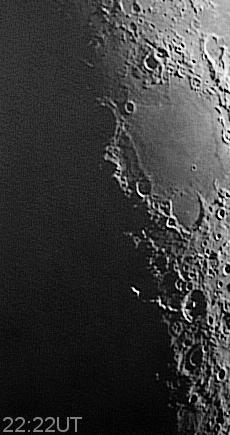
|
The Eastern Hemisphere (50kb)
This is a full frame image with
labels of some of the
major features.
23 June 2004, 04:27UT
|
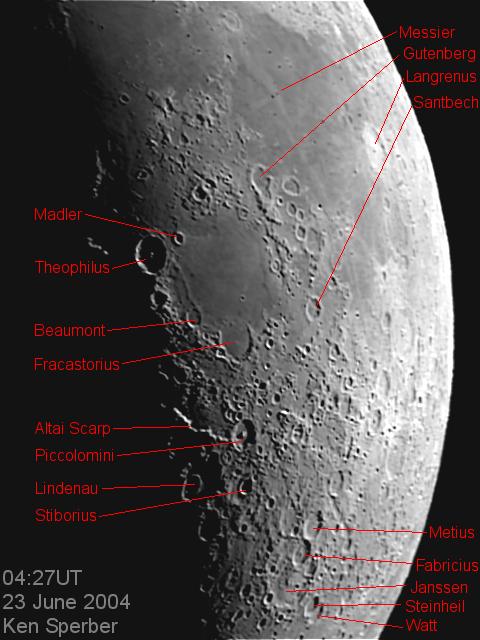
|
The Eastern Hemisphere (40kb)
The image immediately above,
but without the feature labels.
23 June 2004, 04:27UT |

|
The videos were
processed using RegiStax 2 and in each case the best 200 frames were
averaged to yield a single image that was then incorporated into the
movie above. Final image processing was performed using Paint Shop Pro.
All images were converted to black and white, and a variety of
techniques were applied in an attempt to produce consistent "color"
saturation across all images. This was especially challenging as the
images were obtained under direct sunlight, twilight, and nighttime
conditions. Focus changed dramatically during the day, especially in
the late afternoon as the ambient temperature changed rapidly.
The lesson learned is that the focus needs to be adjusted every 20
minutes or so. 8 of the images were rejected
from use in the movie
because they were too out of focus. Daylight
exposures
were at 1/250 second, while those at the end of the session were
1/50 second. The exposure time was changed based on the visibility of
craters etc. in the ToUcam interface. However, once processed, most of
the daylight images were too dark and had less contrast than the
nighttime images. However, the evening images tended to be
overexposed near the eastern limb. Next time I may settle on a single
shutter speed (1/100 second) and find out if the final product is more
uniform. The movie is a cropped version of the original 640x480 webcam
format. Basics of the steps involved at getting consistent "color"
saturation for the above movie are indicated below. The
images at the end of the session tended to be brighter than those
obtained early on, and as such the sunrise highlights were better
defined. As a consequence I increased the brightness of the early
images, which in some case didn't result in the best overall quality.
Raw Image (31kb)
The is a RegiStax 2 processed
image based on the
best 200 frames of the 5-minute video.
22 June 2004, 22:22UT
|
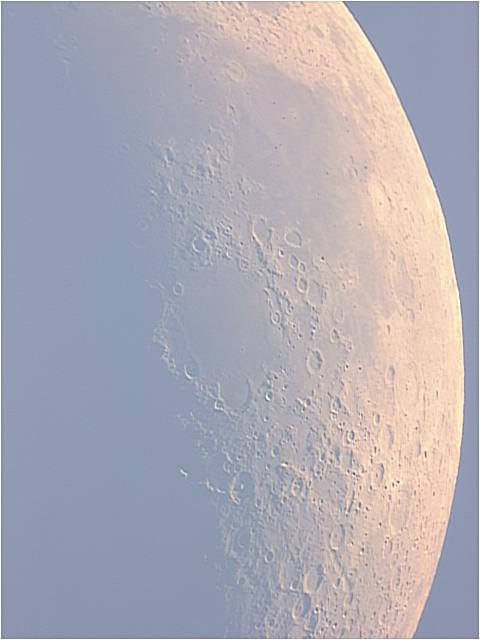
|
Initial Processed Image (45kb)
Using Paint Shop Pro
this image was converted to b/w.
The histogram of brightness values exhibited a very strong peak. I
adjusted the low pixel value to the edge of the histogram peak. This
contrast adjustment was stronger than a simple "stretch."
22 June 2004, 22:22UT
|
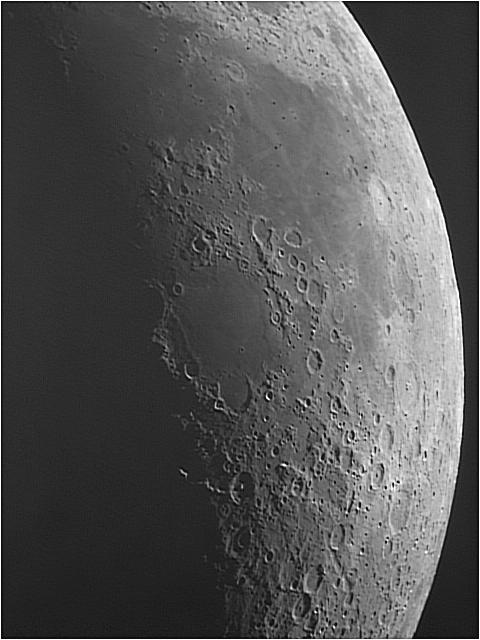
|
Cropped Processed Image (12kb)
Cropped from the image
immediately above, this frame was
dark compared to the nighttime images, and it did not have as much
contrast.
22 June 2004, 22:22UT |
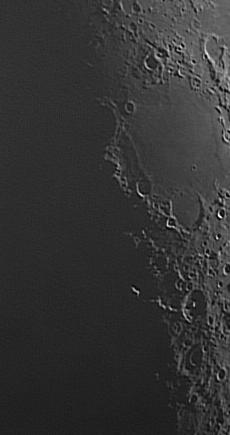
|
Final Processed Image (21kb)
Here the brightness was
increased, the midtones were
expanded, and gamma was set to 1.2.
22 June 2004, 22:22UT |

|
All photos are copyright K.
R. Sperber
Return
to
Ken's
Astrophotography
Homepage